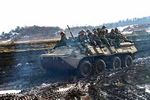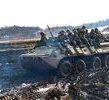
Moscow and Grozny Evince Growing Nervousness Over Regional Security
Publication: Eurasia Daily Monitor Volume: 6 Issue: 206
By:

Today, all Russia’s actions in the south are dictated by the increasingly active armed underground in the North Caucasus and Russia’s desire to oppose its growing influence on the region’s indigenous population. In the summer of 2009 alone 462 acts of violence were reported, while throughout the whole of 2008 only 265 incidents were registered. As a result, more than 442 persons died in the summer of 2009, while there were only 150 deaths reported in the entire year of 2008 (www.regnum.ru, October 28). In other words, the number of acts reported throughout the region by Russia has nearly doubled.
That is why it is not surprising that despite the announced Russian troop level the opposite process is occurring. Troops are being redeployed to the region, in addition to the ones that have been there since the beginning of the second Chechen war in 1999. For example, Nezavisimaya Gazeta reported on October 29 that additional military units are being redeployed to southern Russia from the Moscow area. The 474th detached motor transport battalion was deployed to the town of Millerovo (Rostov oblast) from the town of Dmitrov (Moscow oblast). An anonymous North Caucasus Military District source also told the newspaper that a major reorganization will take place on the basis of Vladikavkaz-based 58th army, where the formation of an operational command is being completed. Instead of two divisions, the command will be comprised of seven motorized infantry brigades and one tank brigade. Until recently, there were two divisions in the 58thh army; the 19th and 42nd divisions, as well as several detached regiments, brigades and battalions. In addition to the two existing mountain brigades, the Botlikh brigade in Dagestan and the Zelenchukskaya brigade in Karachaevo-Cherkessia (www.news.km.ru, October 29), the formation of the 8th detached mountain motorized infantry brigade in Chechnya was completed (located in the village of Borzoi, which is just a couple of kilometers from the Shatoi district center). Besides that, the aviation divisions and regiments of North Caucasus Military District are being transformed into military airbases, each of which will have at least five squadrons at its disposal.
The official reason offered by Moscow for the troop buildup is the supposed weakness of the Russian army in the event of an attack from the south, insinuating an imaginary threat coming from Georgia. In reality, it is not so much about Georgia, which hardly can threaten Russia in any way, but about the overall situation in the region. Armed opposition is no longer seen as something ephemeral. Its roots have expanded into almost all the national republics of the North Caucasus. Taking into consideration the multi-million-strong diaspora abroad (primarily the Circassian diaspora in the countries of Turkey and the Middle East), Russia is trying to reverse the situation by ensuring that it has an absolute multiple-factor advantage in terms of military force.
Analysts have started speculating about the worsening of the situation in the region after the murder of this or that important civil society or political figure in the region. But aside from the famous people being murdered, news briefs are also reporting recurring victims within the local population. Numerous outrages are being perpetrated by unidentified armed people. In most instances those killed are presented as members of the armed opposition. For example, on October 31, three young Shahbiev brothers (Adam, Alsan, and Usman) were shot dead on the border of North Ossetia-Alania and Chechnya, near Mozdok. According to the authorities, they were all combatants and opened fire when they were pulled over. All three were killed, along with a policeman (www.regnum.ru, October 31). However, according to Kavkazsky Uzel (Caucasian Knot) website, all three were about to leave Russia for permanent residence abroad. This does not tally with the official version, since it makes no sense that they would have traveled with guns (www.kavkaz-uzel.ru, November 1). It is worth noting that Zaindi Shahbiev, who was famous not only as a writer, but also as a civil society activist and successful businessman in Moscow, disappeared in February 2008 when he was on his way back home to the Shalazhi settlement of Chechnya’s Urus-Martan district (Novaya Gazeta, June 26, 2008). This kidnapping and the decision of the Shahbiev brothers to leave Russia may well be connected.
More and more often, Chechen President Ramzan Kadyrov is portrayed as participating in military counter-insurgency operations personally and performing the role of the planner of the militants’ liquidation. This was the case on October 31, when security forces in Grozny killed Ali Hassanov, who was accused of being the “leader of the Chechen flatlands,” which casts doubt over whether such a position exists inside the armed opposition. Kavkazsky Uzel reported on November 1 that in October alone the armed forces officially reported killing about 30 suspected combatants in Chechnya.
Meanwhile, not everything is going smoothly in Kadyrov’s relations with his former ally, Ingushetia’s President Yunus-Bek Yevkurov. Disagreements were noted between Kadyrov and Yevkurov regarding operations conducted in the contiguous republics. Kadyrov publicly expressed his displeasure, which caused irritation on the part of Yevkurov, who urged his Chechen colleague not to give him public counsel that he can do without (www.club-rf.ru, October 28).
At the same time, feeling offended by Akhmed Zakaev, who gave an interview to the Russian newspaper Kommersant, Kadyrov declined to further pursue the London-based separatist leader’s return home to Chechnya (www.bbc.co.uk, October 29). The very next day, on the tenth anniversary of the start of the second Chechen war, Chechnya’s pro-Moscow parliament headed by speaker Dukvakha Abdurakhmanov “issued an official decree regarding the dissolution of the ‘Caucasian Emirate’, ‘Ichkeria’ and other structures created by the separatists” (www.lenta.ru, October 30).
In lock step with the growth of tension in the region, an attempt is being made to shift the attention from the North Caucasus to Georgia, where again, with the help of Russian propaganda, the issue of the Pankisi Gorge has once again reemerged (www.svpressa.ru, November 1). Be that as it may, today Russia is being forced to expend far more energy and effort on the North Caucasus than in 2007 or 2008, which may serve as evidence of a deepening conflict. Additional troops in the region cannot provide a shield against the ideological hardening of the armed resistance.




